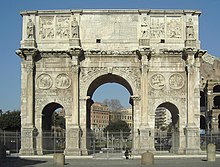315
Appearance
This article needs additional citations for verification. (November 2017) |
| Millennium: | 1st millennium |
|---|---|
| Centuries: | |
| Decades: | |
| Years: |
| 315 by topic |
|---|
| Leaders |
| Categories |
| Gregorian calendar | 315 CCCXV |
| Ab urbe condita | 1068 |
| Assyrian calendar | 5065 |
| Balinese saka calendar | 236–237 |
| Bengali calendar | −278 |
| Berber calendar | 1265 |
| Buddhist calendar | 859 |
| Burmese calendar | −323 |
| Byzantine calendar | 5823–5824 |
| Chinese calendar | 甲戌年 (Wood Dog) 3012 or 2805 — to — 乙亥年 (Wood Pig) 3013 or 2806 |
| Coptic calendar | 31–32 |
| Discordian calendar | 1481 |
| Ethiopian calendar | 307–308 |
| Hebrew calendar | 4075–4076 |
| Hindu calendars | |
| - Vikram Samvat | 371–372 |
| - Shaka Samvat | 236–237 |
| - Kali Yuga | 3415–3416 |
| Holocene calendar | 10315 |
| Iranian calendar | 307 BP – 306 BP |
| Islamic calendar | 316 BH – 315 BH |
| Javanese calendar | 195–196 |
| Julian calendar | 315 CCCXV |
| Korean calendar | 2648 |
| Minguo calendar | 1597 before ROC 民前1597年 |
| Nanakshahi calendar | −1153 |
| Seleucid era | 626/627 AG |
| Thai solar calendar | 857–858 |
| Tibetan calendar | 阳木狗年 (male Wood-Dog) 441 or 60 or −712 — to — 阴木猪年 (female Wood-Pig) 442 or 61 or −711 |

Year 315 (CCCXV) was a common year starting on Saturday (link will display the full calendar) of the Julian calendar. At the time, it was known in Rome as the Year of the Consulship of Constantinus and Licinianus (or, less frequently, year 1068 Ab urbe condita). The denomination 315 for this year has been used since the early medieval period, when the Anno Domini calendar era became the prevalent method in Europe for naming years.
Events
[edit]By place
[edit]Roman Empire
[edit]- Constantine the Great and co-emperor Licinius battle the Sarmates, the Goths and the Carpians along the Danube. Constantine leads a punitive expedition into Dacia and reestablishes the Roman fortifications of the frontier.
- July 25 – The Arch of Constantine is completed near the Colosseum at Rome to commemorate Constantine's victory over Maxentius at the Milvian Bridge. As part of the ceremony Constantine is expected to make a sacrifice to Rome's traditional gods, but he refuses to do so.
- Constantine I dedicates the Basilica of Maxentius and installs a large statue of himself inside it.
- Crucifixion is abolished as punishment in the Roman Empire.
- A program of assistance to the poor is established in the Roman Empire.
- Immense baths are constructed in Augusta Treverorum (modern-day Trier).
By topic
[edit]Religion
[edit]- Eusebius becomes bishop of Caesarea (approximate date).
- The lamb becomes the symbol of Jesus in Christian art.
Births
[edit]- Flavius Hannibalianus, ruler of Armenia and Pontus (d. 337)
- Hilary of Poitiers, Christian bishop and Doctor of the Church[1]
- Himerius, Greek sophist and rhetorician (approximate date)
- Vettius Agorius Praetextatus, Roman politician (d. 384)
Deaths
[edit]

- September 14 – Maternus of Cologne, bishop of Trier
- Du Tao (or Jingwen), Chinese general and rebel leader
- Galeria Valeria, Roman empress and wife of Galerius
- Prisca, Roman empress and wife of Diocletian (b. 247)
- Valerius of Saragossa, Christian bishop and martyr
References
[edit]- ^ "Saint Hilary of Poitiers - bishop of Poitiers". Encyclopedia Britannica. Retrieved November 7, 2017.
